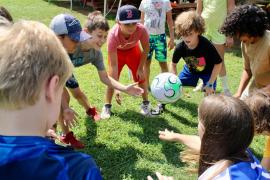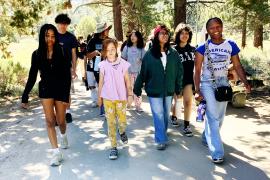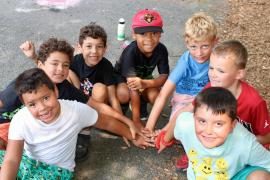A well-known (believed to be an African) proverb advises us, “It takes a village to raise a child” (Goldberg, 2016).
By way of explanation, the Exchange Family Center (EFC) offers, “Back in the day, community living was a given. Dating back thousands of years to somewhat recently, people lived in communities for safety, socialization, and shared resources. From the earliest days of humanity our brains have been programmed to live in close proximity to others, to share food and tools, to protect each other, and to exchange ideas.
“But the past century has drastically changed the concept of community, no matter if you live in a rural area, a suburban neighborhood, or an urban metropolis. Families no longer [cohabit] as intergenerationally as they once did, especially as the appeal of the nuclear family began to increase . . .
“The impact of this is apparent on parents and children. The adage ‘it takes a village to raise a child’ is absolutely still true. But somewhere along the way, we’ve lost the ‘village’ we need to raise kids in nurturing, creative, and safe ways” (EFC, 2021).
Restoring the Village — Or Adding One
Restoring the village — or adding one — is something summer camps are uniquely qualified to do. Why? Because we build communities every year! EFC reminds us, “Building your own community can be hard . . . But in the long run it can be totally worth it.
“Keep in mind that it doesn’t have to happen overnight — and nor should it. Think of establishing a community . . . like growing a garden. You will need to plant the seeds and tend to them slowly and carefully with small steps.”
Sound familiar?
Validation can be found in the oft-expressed sentiment that “camp is my second family” by children of all ages.
There is little doubt that summer camps, and those who work there, can add value to families and schools in developing competent, capable, character-driven boys, girls, and teens. They necessarily promote such favorable youth outcomes as positive identity formation, character development, leadership, civic engagement, social entrepreneurship, and spirituality.
Positive Identity Formation
As young people hurtle toward maturity, they are challenged to master three critical developmental tasks:
- Creating an identity to call their own
- Establishing a reasonable degree of independence from their parents
- Creating more durable and sustainable relationships within their peer group
Facets of each of these tasks emerge throughout childhood, yet the real drive for competency appears most tangible during adolescence, famously noted by psychologist Erik Erikson in his “psychosocial stages of development.” Erikson referred to this particular stage as “identity vs. role confusion” — perhaps highlighting the most urgent of the three tasks. In reality, identity is naturally inclusive of the other two: independence and relationships (Lewis, 2020).
Identity is essentially constructed of how one comes to define oneself across a number of spheres, including socially, emotionally, sexually, and, eventually, vocationally. It may also include race, ethnicity, and ethics. Erikson defined identity as “a subjective sense of invigorating sameness” similar to philosopher John Locke’s concept of psychological continuity (Nimbalkar, 2011).
While that may sound incredibly boring, this stability of self helps provide ballast during the turbulent years of adolescence — which now lasts longer than ever due to younger ages of puberty and older ages of financial independence (not to mention ongoing brain development).
Not all the antecedents of a “fixed” or “fluid” identity are likely known. Yet it is safe to say there are at least a couple of important ways to shape the identity formation process.
First, young people quite literally “try on” different roles or personalities, which is one reason they may appear different from one day to the next. This sampling of selves helps them to discern those aspects of an identity that provide maximum satisfaction and reward, including the reactions of significant figures in their lives, which also include those they meet at summer camp. Indeed, Erikson said that to experience wholeness, young people must feel continuity between how they think of themselves and how they perceive others think of them.
Second, young people may cherry-pick characteristics of others they find appealing, effective, or successful and merge these into their whole. In other words, they may incorporate into their identity traits of others they admire, such as honesty, humor, patience, or leadership.
Camp professionals and summer staff can help move young people along the path of identity formation by doing the following:
- Encourage campers to pursue a wide range of interests and a sampling of activities, relationships, and personal traits.
- Support them as they adjust to separation from their parents and learn to solve problems on their own or to seek help from others.
- Teach and role-model appropriate social skills that will aid them in establishing and maintaining friendships within their camps, schools, and broader communities.
When we do those three simple things, we help children emerge as confident, resourceful, and caring young adults.
Freud said that this process of “identification” is inevitably predicated on an emotional tie with the individual. Not surprisingly, then, parents (and other significant adults, such as teachers, coaches, and camp staff) again play a determinant role.
Another developmental theorist, James Marcia, set forth the notion that the so-called “identity crisis” arises when young people become cognitively capable of considering whom they want, or need, to become in order to handle the challenges of adulthood (Oswalt Morelli, 2021).
Theories aside, it could simply be an assignment that kicks off the march toward answering the seminal question: “Who am I?”
Who They Become
For us, perhaps a more relevant view focuses on “who they become,” given that the programmatic aspects of what we do at camp are centered around intentionality in terms of outcomes of the experiences we offer to children. That may be especially the case with regard to moral and character development.
Thick and Thin
New York Times columnist David Brooks, in his piece “How to Leave a Mark on People,” points to employment at a Connecticut summer camp (Incarnation) as an analog for what University of Virginia researchers James Davidson Hunter and Ryan Olson refer to as “thick” (vs. “thin”) (Brooks, 2017).
What’s the difference?
According to Brooks, “A thick institution becomes part of a person’s identity and engages the whole person: head, hands, heart, and soul. So thick institutions have a physical location, often cramped, where members meet face to face on a regular basis, like a dinner table or a packed gym or assembly hall. Such institutions have a set of collective rituals — fasting or reciting or standing in formation. They have shared tasks, which often involve members closely watching one another, the way hockey teammates have to observe everybody else on the ice. In such institutions people occasionally sleep overnight in the same retreat center or facility, so that everybody can see each other’s real self, before makeup and after dinner.”
On that last point, Joe Benjamin, a longtime camper and teen leader, told me in an email, “Living with new and different people for seven weeks is not always easy. It can be cramped, dirty, smelly, and downright unpleasant at times. However, there is no better way to get to know people than to live with them.”
Conversely, thin organizations exist along a “horizontal plane” as opposed to a “vertical axis.” People join for mutual gain.
Of course, summer camps are but one example in a sea of thick organizations (including schools, religious organizations, gap-year programs, theater groups, and sailing expeditions) that offer meaningful opportunities for moral and spiritual growth. But, to me, camps stand out as being particularly thick.
Angela Duckworth, the founder and scientific director of the Character Lab, whom Brooks quotes, said in a Twitter post, “Thick cultures are the crucible of character. What makes a thick culture? Not one thing. Many.”
Admirably, Duckworth and her colleagues have developed a measure (Character Growth Mindset) to ensure that young people and those who guide them are focused on the right things (i.e., the “many”) (Haimovitz and Yeager, 2021). Great Schools Partnership uses a Character Growth Card to measure the following.
- Curiosity — Eager to learn new things, ask questions to learn better, show an active interest
- Gratitude — Mindful of what others do for them, demonstrate and express appreciation, perform acts of kindness for others
- Grit — Completes tasks at hand, exhibits effort even in the face of failure, remains committed to goals even when quitting is an option
- Optimism — Views effort as a path forward, reflects on setbacks, and remains motivated to do better next time
- Self-control — Remains calm when criticized, allows input of others, demonstrates politeness to peers and adults, regulates anger, prepares, remembers and follows instructions, takes initiative, resists distractions
- Social intelligence — Finds solutions amid conflicts, demonstrates respect for feelings of others, adapts to different social environments
- Zest — Participates actively, shows enthusiasm, approaches new situations with excitement and energy
One may argue that another hallmark of thick organizations is that they are a breeding ground for emotional intelligence or “EQ.”
Camp expert Posie Taylor calls emotional intelligence “camp’s secret weapon,” writing, “Observers are finding that a set of abilities, collectively called emotional intelligence, has much to do with how children grow and succeed. These skills — self-awareness, self-control, empathy, delayed gratification, the ability to listen, cooperate, share and work well with others — are actually better predictors of adult success and happiness than traditional IQ scores” (Taylor, 2011).
Taylor continues, “Children away from home with new friends and the new challenges of camp, learn much about themselves, such as their own strengths and abilities. Away from the familiarity of home and school, campers can test their own perseverance. With caring and thoughtful help, they build new life skills for themselves.”
And along the way they earn self-esteem.
Embedded in emotional intelligence, along with empathy, are the powerful constructs of both sympathy and, perhaps more important, compassion.
Character, Contribution, and the Social Entrepreneur
Despite what we hear in the media about generational changes that have left kids more narcissistic and less empathetic than their parents or grandparents, is it possible that American youth get a bad rap?
Perhaps it’s hard to notice that scores of young people are quietly going about the task of improving lives everywhere. Indeed, civic-mindedness prevails.
In response to growing interest in service and leadership, programs that promote social change have sprung up nationwide. One such organization is the LeaderShape Institute, founded in 1986 by Alpha Tau Omega Fraternity. It was designed as a means of improving campus leadership and now partners with institutions across the country and around the world to promote the development of young people as leaders on and off campus.
My recent visit with LeaderShape students revealed a life-changing experience that effectively communicates “a commitment to a healthy disregard for the impossible.” It focuses youth on a process of committing to a vision and developing the relationships necessary to make that vision a reality, all the while maintaining a high degree of personal integrity.
It appears that the development of certain character traits — often through the simple communication of “life lessons” at home, school, or camp — may platform an interest in leadership by creating change for the good of others. When that activity involves starting or extending an organization, it is called “social entrepreneurship.”
Social entrepreneurs not only inspire change but also provide hope.
Those we hear about most often are successful adults, but young people have a critical role to play as well.
Compelling examples of youth creating change can be found in the stories of three camp alumni: Julie Barbera, then a student at Scarsdale High School in New York, started a chapter of the national Students Against Destructive Decisions (SADD) organization to promote a more dependable and compassionate school community; Justin Deckert, while a student at Colby College in Maine, launched a learning differences task force to address underserved peers struggling with course work; and Pierce Keegan, while a high school student in Massachusetts, founded Pierce’s Pantry, a nonprofit gluten-free food bank for Celiac Disease families unable to pay for food.
The character traits they identify as instrumental to their entrepreneurship include:
- Determination
- Independence
- Accountability
- Respectfulness
- Initiative
- Dependability
- Patience
- Trustworthiness
- Cooperation
- Industriousness
- Loyalty
- Responsibility
- Creativity
- Inventiveness
Research suggests that entrepreneurial characteristics such as these can be taught.
Making Magic for a Century and Beyond
For over a century, summer camps have demonstrated the capacity to drive enriching and life-altering experiences for youth. By adding a village of key individuals already devoted to personal growth, camps can inform identity formation, character and moral development, and social entrepreneurship, to name just a few — and it is your leadership role that makes this magic possible, now and in the future.
Raising kids right takes more than a village, indeed.
Photo courtesy of Teton Valley Ranch Camp, Dubois, WY
Stephen Gray Wallace, MS Ed, is a doctoral candidate in ethical leadership at St. Thomas University in Miami, Florida. He is also an associate research professor and president and director of the Center for Adolescent Research and Education (CARE). Stephen has broad experience as a camp director and school psychologist. He is a member of the professional development faculties at the American Academy of Family Physicians and American Camp Association and a parenting expert at kidsinthehouse.com, NBC News Learn, and WebMD. He is also an expert partner at RANE the Risk Assistance Network & Exchange (RANE) and was national chairman and chief executive officer at SADD for 16 years. Stephen is an award-winning writer and author of the books Reality Gap and IMPACT. Additional information about Stephen’s work can be found at StephenGrayWallace.com.
(c) Summit Communications Management Corporation 2022. All Rights Reserved.
References
@angeladuckw. (2017, April 18). Thick cultures are the crucible of character. What makes a thick culture? Not one thing. Many. Twitter. nytimes.com/2017/04/18/opi
Brooks, D. (2017, April 18). How to leave a mark on people. The New York Times. nytimes.com/2017/04/18/opinion/how-to-leave-a-mark-on-people.html
Character Lab. (2021). About us. characterlab.org/about/
Exchange Family Center. (2021, February 7). It takes a village to raise a child: How communities can help raise kids. exchangefamilycenter.org/exchange-family-center-blog/2021/2/4/it-take-a-village-to-raise-a-child-how-communities-can-help-raise-kids
Goldberg, J. (2016, July 30). It takes a village to determine the origins of an African proverb. Goats and Soda. National Public Radio. npr.org/sections/goatsandsoda/2016/07/30/487925796/it-takes-a-village-to-determine-the-origins-of-an-african-proverb
Great Schools Partnership. (2020). What is a character growth card? greatschoolspartnership.org/wp-content/uploads/2016/11/CharacterGrowthCard.pdf
Haimovitz, K. & Yeager, D. (2021). Growth mindset. Character Lab. characterlab.org/playbooks/growth-mindset/
IASC News. (2017, April 18). David Brooks on thin and thick moral frameworks. Institute for Advanced Studies in Culture. University of Virginia. iasculture.org/news/brooks-moral-ecology-nyt
LeaderShape. (2021). The LeaderShape Institute. leadershape.org/institute
Lewis, R. (2020, April 28). Erikson’s 8 stages of psychosocial development, explained for parents. Healthline. healthline.com/health/parenting/erikson-stages
Morelli, A. O. (2021). James Marcia and self-identity. Child Development Theory: Adolescence (12-24). Gracepoint. gracepointwellness.org/1310-child-development-theory-adolescence-12-24/article/41164-james-marcia-and-self-identity
Nimbalkar, N. (2011). John Locke on personal identity. Mens sana monographs, 9(1). ncbi.nlm.nih.gov/pmc/articles/PMC3115296/#:~:text=John%20Locke%20holds%20that%20personal,the%20soul%20or%20the%20body
Taylor, P. (2011, March 15). Camp’s secret weapon: The buzz about emotional intelligence and your child. St. Louis Post-Dispatch. stltoday.com/camps-secret-weapon-the-buzz-about-emotional-intelligence-and-your-child/article_ff3d5ce4-48e3-11e0-8bec-00127992bc8b.html






